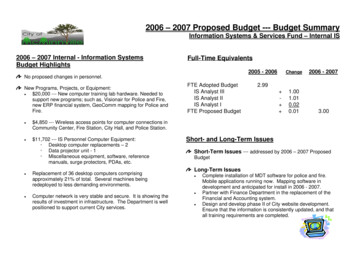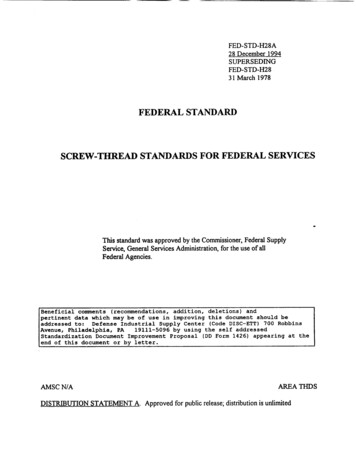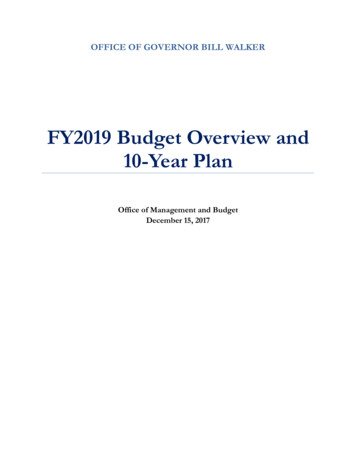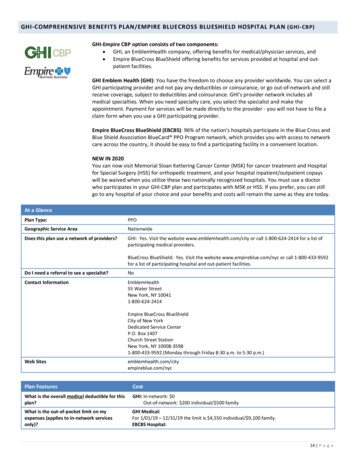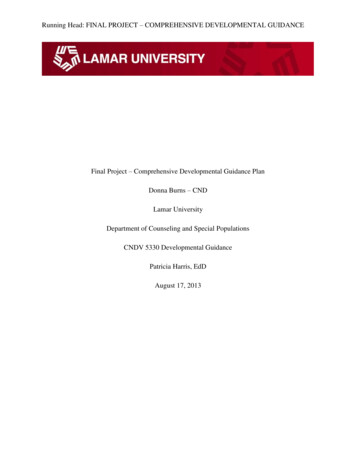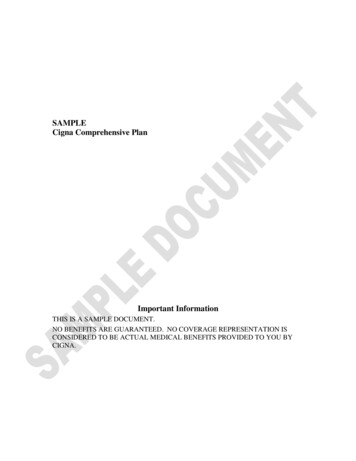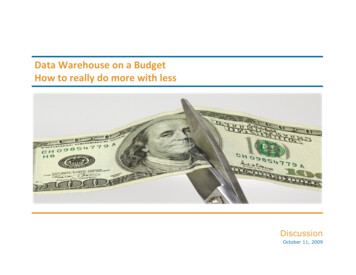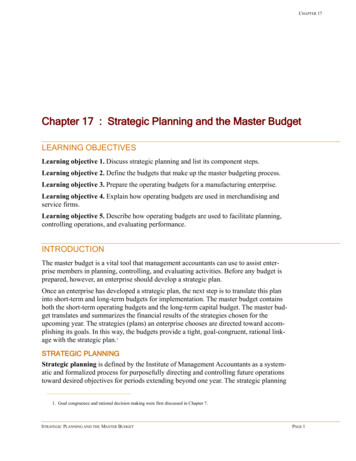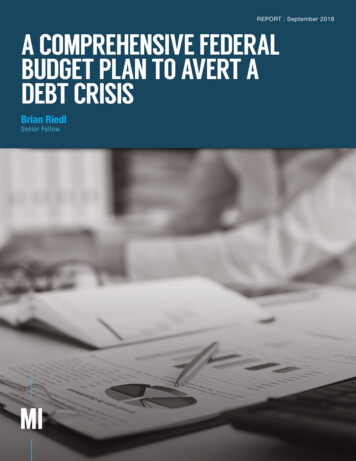
Transcription
REPORT September 2018A COMPREHENSIVE FEDERALBUDGET PLAN TO AVERT ADEBT CRISISBrian RiedlSenior Fellow
A Comprehensive Federal Budget Plan to Avert a Debt CrisisAbout the AuthorBrian Riedl is a senior fellow at the Manhattan Institute and a member of MI’s Economics21,focusing on budget, tax, and economic policy. Previously, he worked for six years as chief economistto Senator Rob Portman (R-OH) and as staff director of the Senate Finance Subcommittee on FiscalResponsibility and Economic Growth. He also served as a director of budget and spending policyfor Marco Rubio’s presidential campaign and was the lead architect of the 10-year deficit-reductionplan for Mitt Romney’s presidential campaign.During 2001–11, Riedl served as the Heritage Foundation’s lead research fellow on federal budgetand spending policy. In that position, he helped lay the groundwork for Congress to cap soaringfederal spending, rein in farm subsidies, and ban pork-barrel earmarks. Riedl’s writing and researchhas been featured in, among others, the New York Times, Wall Street Journal, Washington Post, LosAngeles Times, and National Review; he is a frequent guest on NBC, CBS, PBS, CNN, FOX News,MSNBC, and C-SPAN.Riedl holds a bachelor’s degree in economics and political science from the University of Wisconsin and a master’s degree in publicaffairs from Princeton University.2
ContentsExecutive Summary.4Introduction.5I. Why the Debt Is Soaring.6II. The Mirage of “Easy” Solutions.9III. A Blueprint to Stabilize the Long-TermFederal Budget.13IV. In Defense of the Plan.24Conclusion.26Endnotes.283
A Comprehensive Federal Budget Plan to Avert a Debt CrisisExecutive SummaryAnnual budget deficits are projected to soon surpass 1 trillion, on their way to 2 trillion or even 3 trillion in10 to 15 years. Social Security and Medicare face a combined 100 trillion cash deficit over the next 30 years,which would push the national debt to nearly 200% of the gross domestic product (GDP). At that point, intereston that debt would consume 40% of all tax revenues—or more, if interest rates rise. Unless reforms are enacted,global markets will, at some point, stop lending to the U.S. at plausible interest rates. When that event occurs,or even approaches, interest rates will soar, and the federal government will not be able to pay its bills, with direconsequences for the U.S. economy.A debt crisis, in short, looms on the horizon.There is a way to avert this debt crisis. However, lawmakers must act quickly to reform Social Security and Medicare, as every year 4 million more baby boomers retire into those programs, and the eventual cost of reform risesby trillions of dollars.This report presents a specific 30-year blueprint—each element of which is “scored” using data from the Congressional Budget Office (CBO)—to stabilize the national debt at 95% of GDP.The fiscal consolidation in this report calls for some Social Security and Medicare benefits for upper-incomerecipients to be trimmed. Some taxes would rise. Spending on defense would continue to fall as a share of theeconomy. But antipoverty reforms would be limited to a slight reduction in the growth of Medicaid benefits, anddomestic discretionary spending priorities would be largely protected.Without reform, runaway deficits will all but guarantee a debt crisis that will profoundly damage the country’seconomic and social order. There is still time to avoid that crisis, but it will require the nation’s fractious politicalleaders to leave their respective comfort zones and compromise.4
A COMPREHENSIVE FEDERALBUDGET PLAN TO AVERTA DEBT CRISISIntroductionAnnual budget deficits are projected to soon surpass 1 trillion, on their way to 2 trillion or even 3 trillion in10 to 15 years. Social Security and Medicare face a combined 100 trillion cash deficit over the next 30 years,which is projected to bring a 100 trillion national debt. At that point, interest on that debt would consume 40%of all tax revenues—or more, if interest rates rise. Unless reforms are enacted, global markets will, at some point,stop lending to the U.S. at plausible interest rates. When that event occurs, or even approaches, interest rates willsoar, and the federal government will not be able to pay its bills, with dire consequences for the U.S. economy.A debt crisis, in short, looms on the horizon, yet most lawmakers tasked with the responsibility of averting itexpress little interest in doing so. No recent president has presented a specific plan to stabilize the long-termbudget. Congress recently enacted tax cuts and discretionary spending increases that—irrespective of any policymerits—will add trillions in debt. Lawmakers promise cheering crowds that they will never trim Social Securityor Medicare or accept a penny in new tax increases or defense cuts. Democratic socialists pledge to further increase federal spending by 42 trillion over the decade and 218 trillion over 30 years.1 Federal spending rises by 150 billion annually2 while bipartisan resistance greeted a proposal this summer to merely rescind a few billiondollars in spending authority that was not going to be spent anyway.3Petty squabbles over petty spending cuts—and the refusal even to discuss the main drivers of debt—reflect ageneral unwillingness of Congress, the White House, and, indeed, the citizenry to face the unsustainability ofWashington’s current fiscal path.There is a way to avert this debt crisis without major tax increases or significant cuts to antipoverty and socialspending. However, lawmakers must act quickly to reform Social Security and Medicare, as every year 4 millionmore baby boomers retire into those programs, and the eventual cost of reform rises by trillions of dollars.This report presents a specific 30-year blueprint—each element of which is “scored” using the most recent Congressional Budget Office (CBO) Long-Term Budget Outlook—to stabilize the national debt at 95% of thegross domestic product (GDP). Section I identifies the drivers of the long-term debt. Section II addressesfalse “easy” solutions deployed to avoid real reform. Section III presents the blueprint. Section IV defends theblueprint against both conservative and liberal objections.The fiscal consolidation in this report calls for some Social Security and Medicare benefits for upper-incomerecipients to be trimmed. Some taxes would rise. Spending on defense would continue to fall as a share of theeconomy. In short, there is something in this blueprint for everyone to oppose. But letting the country wanderinto a debt crisis is even worse.To be sure, deficit-reduction proposals are common. The problem is that most congressional budget proposalssimply assume generic (and unrealistic) long-term spending and tax targets without spelling out the specificprogrammatic reforms that could meet those targets. Across the policy community, long-term budgetproposals often reflect liberal or conservative dream scenarios rather than plans that can appeal to both parties.5
A Comprehensive Federal Budget Plan to Avert a Debt CrisisBy contrast, the blueprint presented here is specific,scored, and represents politically realistic solutionsrather than partisan fantasies. It is intended to reviveserious bipartisan discussion and negotiations.edented tax increases; higher interest rates for homemortgages and car, student, and business loans; anda significant economic slowdown. Unlike Greece’s, theU.S. debt would be too large to be easily absorbed bythe global economy.I. Why the Debt IsSoaringWhat is causing the debt rise? Not inadequate tax revenues—which, since the early 1950s, have usually remained between 16.5% and 18.5% of GDP, regardlessof tax policies, and which are projected to rise abovehistorical norms, to 18.6%–19.8% of GDP, dependingon the fate of various expiring tax cuts and delayed taxincreases.8 Nor is it driven, on the spending side, byaggregate expenditures for discretionary and smallerentitlement programs, which are projected to continuefalling as a share of the economy.From the mid-1950s through 2008, the national debtheld by the public averaged 35% of GDP.4 This level ofborrowing could easily be absorbed by the increasingly global financial markets, and it resulted in interestcosts averaging 2% of GDP (roughly 10% of a typicalfederal budget). Since 2008, the great recession andthe beginning of the baby-boomer retirements havemore than doubled the debt, to 78% of GDP. If currentpolicies continue, the debt is projected to reach an unprecedented 194% of GDP within 30 years.5 And if thisdebt brings higher interest rates (as consensus economic theory suggests),6 the debt could surpass 250%of GDP (Figure 1),7 and servicing the debt could cost7.5% of GDP—the equivalent of 1.5 trillion in today’seconomy. Americans of all incomes would face unprec-Figure 2 shows that the entire increase in long-termdebt will come from surging Social Security, Medicare,and other government health-care spending. According to the CBO, these costs have risen from 7% to 10%of GDP since 2000 and are projected to reach 15.5%of GDP by 2048—or 21.8% of GDP when the interestcost of Social Security and Medicare’s annual deficitsare included.FIGURE 1.Interest Rates and the Debt-to-GDP RatioNational Debt Held by the Public (%GDP)300%250%200%Average interest rate paid on national –2820483.2% (CBO projection)4.4% (CBO projection9%8%7%6%211%5%150%100%194%Current - Policy BaselineAverage Interest Rate Rises to 4.4% by l YearSource: See note 2. Alternative interest rates would be phased in, beginning in 2029.6291%270%249%229%2035203720392041204320452047
FIGURE 2.Federal Budget 1960–2048 (Projected)35%30%Revenues25%7.5%Percent of GDPNet Interest20%15.5%15%Social Security & Health Entitlements10%Other Entitlements5%Nondefense DiscretionaryDefense & 2040Fiscal YearSource: CBO, “2018 Long-Term Budget Outlook,” adjusted into a current-policy baselineWhy Social Security and MedicareAre Going BankruptBetween 2008 and 2030, 74 million Americans bornbetween 1946 and 1964—on average, 10,000 per day—will retire and receive Social Security and Medicarebenefits. Of this group, those retiring at age 66 andliving to age 90 will spend one-third of their adult lifereceiving federal retirement benefits. The combinationof more retiring baby boomers and longer life spanswill expand Social Security and Medicare caseloadsfar beyond what current taxpayers can afford undercurrent benefit formulas. In 1960, five workers paid thetaxes to support each retiree (and, of course, Medicaredid not exist). The ratio of workers to retirees has nowfallen below 3–1, on its way to 2–1 by the 2030s. Whentoday’s kindergartners are adults, each married couplewill basically be responsible for the Social Security andhealth care of their very own retiree.These demographic challenges are worsened by risinghealth-care costs and repeated benefit expansionsenacted by lawmakers. Today’s typical retiring couplehas paid 140,000 into Medicare and will receive 420,000 in benefits (in net present value), in partbecause Medicare’s physician and drug benefits arenot pre-funded with payroll taxes, and only partial-ly funded by retiree premiums. Most Social Securityrecipients also come out ahead.9 Thus, most seniors’benefits greatly exceed their lifetime contributions tothe Social Security and Medicare systems. By 2030,the 74 million baby boomers will have joined a retirement benefit system that runs a substantial per-persondeficit.According to CBO, between 2018 and 2048, Medicareis projected to run a 41 trillion cash deficit, SocialSecurity will run an 18 trillion cash deficit, and theinterest on the resulting program debt will be 41 trillion (Figure 3).10 (To adjust these 30-year totals forinflation, trim by one-third.) Rather than adequatelyself-finance through payroll taxes and premiums, thesetwo programs are set to add 100 trillion to the national debt. The rest of the federal budget is projected torun a surplus over the next 30 years.Figure 4 expresses the same projections in a differentmanner. By 2048, Social Security and Medicare willcollect 5.9% of GDP in dedicated revenues and spend12.2% of GDP in benefits—plus 6.3% of GDP in interest costs resulting from these two programs’ deficits.That 12.6% of GDP budget deficit resulting solely fromSocial Security and Medicare is unsustainable.7
A Comprehensive Federal Budget Plan to Avert a Debt CrisisFIGURE 3.FIGURE 4.Social Security and Medicare Face a 100 Trillion Cash Deficit Between 2018and 2048*Projected 2048 Federal Deficits Are DrivenEntirely by Social Security and MedicareShortfalls20%- 518%- 10- 1516% -18.1- 25- 30- 35- 45 -40.6 -41.3- 40Social SecurityDeficitMedicareDeficitInterest Cost ofSocial Security& MedicareDeficitsSource: See note 5. To adjust for inflation, trim amounts by one-third.*Social Security and Medicare deficits are the benefits that must be paid from generalfederal tax revenues (including interest payments on bonds held by the two programs’trust funds) rather than from the money in the trust funds themselves, such as payroll taxes and Medicare premiums. CBO assumes that full benefits will continue to be paid evenafter trust funds are exhausted. Interest costs include only those paid on the projectedborrowing to cover the 59.4 trillion 2018–48 Social Security and Medicare shortfalls.The Fiscal Winter Is Coming—andAutumn Has Already ArrivedSince 2008—when the first baby boomers qualified forearly retirement—Social Security and Medicare haveaccounted for 60% of all inflation-adjusted federalspending growth (with Medicaid and the AffordableCare Act responsible for an additional 31%). The majority of budgetary savings achieved by discretionaryspending caps, defense cuts, and rising tax revenueshave simply financed growing Social Security andMedicare costs, which will grow by another 130 billionannually over the next decade.11 That is the equivalentof creating another Defense Department every fiveyears. This will happen automatically, without any congressional votes and therefore likely with scant mediacoverage.And as federal resources further shift to the elderly,Washington is beginning to run out of offsettingspending cuts. This has contributed to the deficit expanding from 438 billion to 666 billion over the pasttwo years. CBO’s current-policy baseline shows deficitsrising to 2 trillion within a decade—or 3 trillion, if818.5%Outlays14%- 20Percent of GDPSurplus/Deficit in Nominal Trillions tedRevenues0%Social Security &Medicare SystemsRest of FederalBudgetSource: CBO, “2018 Long-Term Budget Outlook,” converted into a current-policy baseline.Each outlay category includes the portion of national debt interest attributed to its2018–48 deficits.interest rates return to historical norms. Unlike thetemporary, recession-driven budget deficits a decadeago, these Social Security- and Medicare-based deficits will expand permanently. Over the next 30 years,CBO projects that the national debt will grow from 20trillion to 99 trillion ( 54 trillion after inflation)—ormuch higher, if interest rates rise from the projected3%–4% range to the historically typical 5%–6%.President Trump’s latest budget proposal shows the impossibility of reining in deficits without Social Securityand Medicare reform. By allowing these programs tonearly double over the decade, from 1.6 trillion to 3.0trillion, the White House is forced to propose slashingother entitlement spending as a share of GDP by onefifth over the decade and cutting both defense and domestic discretionary spending to levels—as a percentage of GDP—unseen since the 1930s. Yet even if theseimplausible cuts were enacted, CBO still estimates abudget deficit topping 1 trillion by 2028.12 This deficitwould continue escalating thereafter because Social Security and Medicare costs would continue growing evenafter Washington would have run out of other spendingto cut.
Predictably, most of the popular blame for the risingdeficits is currently pinned on the 2017 Tax Cuts andJobs Act (TCJA). TCJA will likely decrease revenuesby roughly 1% of GDP indefinitely if extended past2025, when parts of the law are currently scheduledto expire.13 (This does not include additional tax revenues that will arise from economic growth that lowertax rates will induce. The congressional Joint Committee on Taxation estimates that these additional taxrevenues would offset the additional interest costs ofthe tax law, though not the primary deficit-increasingimpact of the tax cuts themselves.) While the government revenues forgone by TCJA will surely worsen deficits, they are a much smaller contributor than SocialSecurity, Medicare, and Medicaid, spending on whichwill together rise by 2.6% of GDP over the decade and5.4% over 30 years.14 Even without the 2017 tax cuts,the annual deficit would still exceed 1.7 trillion withina decade. In short, TCJA did not create the federalgovernment’s large deficits, and even repealing themwould not absolve lawmakers of the need to addressrising entitlement spending.How a Crisis May Play OutThe national debt’s share of the economy cannot riseforever. At a certain point, even large global savingsmarkets will be stretched, and investor confidence inAmerica’s ability to finance its debt will evaporate. Thetiming of a country’s debt crisis depends as much onmarket psychology as on economic fundamentals. Buteventually, as the debt steeply escalates, investors willmove from unease to panic and demand higher interestrates to finance the federal government. These higherrates will make it extremely difficult for businesses toborrow and invest, and will make auto loans, studentloans, and home mortgages less affordable, while alsoforcing unprecedented tax increases and/or spendingcuts to pay for Washington’s higher interest costs. Suchan outcome is highly likely if annual deficits continuegrowing past 10% of GDP and the debt continues toapproach 200% of GDP, as projected in the currentpolicy baseline. On the one hand, America will havesome leeway due to its reputation as a safe harbor forinvestment and status as the world’s reserve currency.On the other hand, absorbing a debt of nearly 200%of America’s economy would be much more expensivefor the global markets than absorbing, say, 200% of asmaller GDP, like that of Greece.In the absence of fundamental reform, the more likelyscenario is a series of minor investor panics (forcingup interest rates), followed by upper-income tax increases and lower-priority spending reductions thatare insufficient to finance the rising entitlement andinterest costs. Eventually, Washington will run out ofsuch offsets to reduce deficits, leaving only the choicebetween historically large middle-class tax increasesand a drastic reduction in Social Security and Medicarebenefits for current retirees.II. The Mirage of “Easy”SolutionsStanding in the way of making the changes to be outlined in this budget plan—or other plausible proposalsto avert a debt crisis—are a series of false claims thatthe problem is easily solved.Economic PanaceasSteep economic growth. A strong economy is necessary but far from sufficient for major deficit reduction.Growth rates will already be limited by the labor-forceslowdown caus
A Comprehensive Federal Budget Plan to Avert a Debt Crisis 6 By contrast, the blueprint presented here is specific, scored, and represents politically realistic solutions rather than partisan fantasies. It is intended to revive serious bipartisan discussion and negotiations. I. Why the Debt
